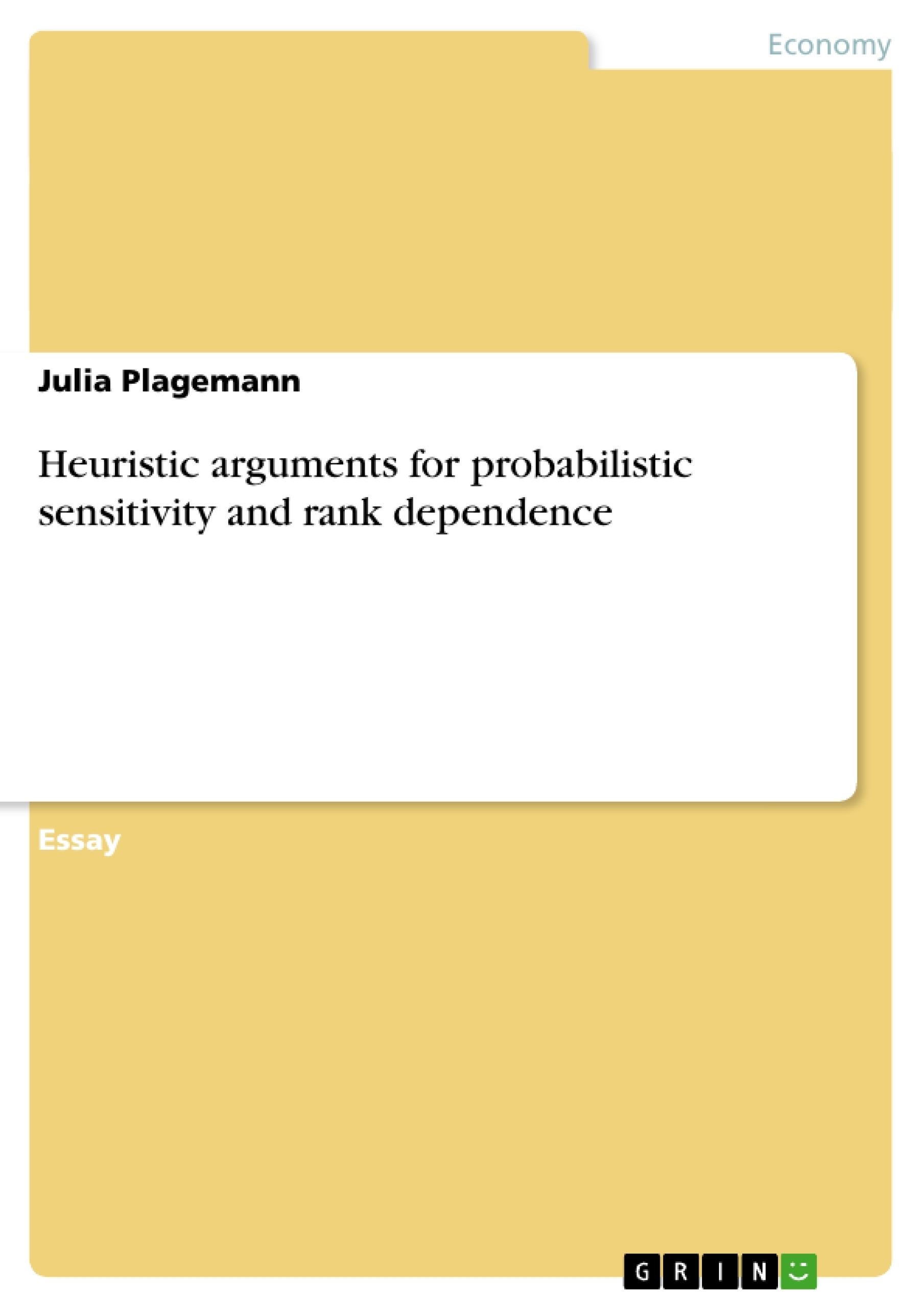Excerpt
Table of contents
Abbreviations
Figures
Appendices
I Introduction
II Non-Linearity of Risk Aversion
III Proposal For a Solution to the Problem of Non-Linearity of Risk Aversion
IV Rank-Dependent Utility
V Summary
References
Appendix
Abbreviations
illustration not visible in this excerpt
Figures
Figure 1: Distribution of Probabilities of Option A in Dependence of Option B
After von Neumann and Morgenstern
Figure 2: Function of Diminishing Utility (and Risk)
Figure 3: Non-Linear Distribution of Risk
Figure 4: Probabilities and Outcomes
Appendices
Appendix 1: Underlying Data of Graphic Illustrations
I Introduction
In Chapter 5 of his work "Prospect Theory", Wakker (2010) substantially aims to demonstrate the superiority of a rank-dependent utility (meaning a hierarchical sorted utility) over the "old" expected utility theory, which pre- sumes a linearity of utility. The relevant parameters by which the expected utility of its "founders" (von Neumann and Morgenstern (1944) is com- posed, are the utility, which is linked to a decision option, and the probabil- ity of occurrence, the likelihood that the decision option will lead to the de- sired outcome. A decision problem for person 1 between the decision op- tions A and B, therefore, is demonstrated as the choice of probabilities of occurrences, which by Neumann and Morgenstern (1944) were shaped linearly as follows:
illustration not visible in this excerpt
Thus the probability after von Neumann and Morgenstern becomes an output-oriented choice between the different option's probabilities. Figure 1 shows the relationship between two options A and B for two randomly chosen distributions as a probability distribution function:
Figure 1: Distribution of Probabilities of Option A in Dependence of Option B After von Neumann and Morgenstern1
illustration not visible in this excerpt
Outcome
Source: Own illustration on the basis of numbers shown in appendix 1.
As can be learnt from figure 1, the probability of the choice of option A increases linearly, whereas the corresponding probability for option B can be seen as a directly opposed probability, which decreases to the same degree to which the probability of option A increases. The two options are essentially inversely correlated with one another.
This graphic illustration implies the conviction, that the choice between two options is a choice between equally weighted risks, whereas the one option is chosen, for which the product of risk (probability) and utility is most beneficial. An outcome of 10 (see figure 1) therefore is more likely for option B, while an outcome of 25 is more likely for option A.
Contrary to this assumption of linearity a number of objections were produced, which were also addressed by Tversky and Kahnemann in their work published in 1986.
In his contributing article, Wakker (2010) aims to identify an intuitive heuristic, pointing out that the improvement of identifying risk as a non-linear parameter determined by a rank dependent utility should be made. Therefore he divides Chapter 5 into three different parts:
1) The first part argues that risk aversion is not linear
2) Part two shows, that former suggested psychological solutions in order to do justice to the non-linearity of risk aversion are not sufficient
3) Finally, part three presents the concept of rank dependent utility
II Non-linearity of risk aversion
The point of origin for all of Wakker's further analyses is the observation that the utility and the risk, which is linked to another unit of utility, do not develop linearly. This idea, which stems from the concept of marginal utili- ty, can be summarized as follows: The utility of gaining one unit of "utility" (not necessarily only money as Wakker assumes) then is lower, if the gain occurs on the basis of 66 utility units, than if the gain occurs on the basis of 34 utility units. Equally, the risk (due to linearity), which is linked to the gain of one unit on the basis of 33 units, is estimated to be higher than the risk, that is linked to the gain of a unit on the basis of 66 units. From this it follows that with an increasing utility basis the utility generated from one more unit diminishes, and so does the corresponding supplemental risk. This assumption of the marginal utility leads to the concave utility function, which is demonstrated in figure 2.
Figure 2: Function of Diminishing Utility (and Risk)
illustration not visible in this excerpt
Outcome
In his work, Wakker points out that psychologists allude to risk aversion not as a linear function, as illustrated in figure 1, but as a concave function as shown in figure 2 : "An additional argument against EU [expected utility] concerns the considerable risk aversion that is found empirically for small amounts of money, because it is not plausible that the marginal utility of money changes as much over small amounts as is required to explain such risk aversion” (Wakker, 2010, S.147). This transforms the decision theory to being subjective and sets a higher value on the individual risk estimation than the relevance attached to the risk-corresponding utility. This conclusion is supported by part two in Wakker's chapter 5 of "Pros- pect Theory", in which psychological variants are introduced modeling the greater individual emphasis on risk and allowing for the non-linearity of risk and utility.
[...]
1 Options A and B were generated as data from 1 through 30, the probabilities for A and B were generated randomly.
- Quote paper
- Julia Plagemann (Author), 2011, Heuristic arguments for probabilistic sensitivity and rank dependence , Munich, GRIN Verlag, https://www.grin.com/document/183122
Publish now - it's free






















Comments